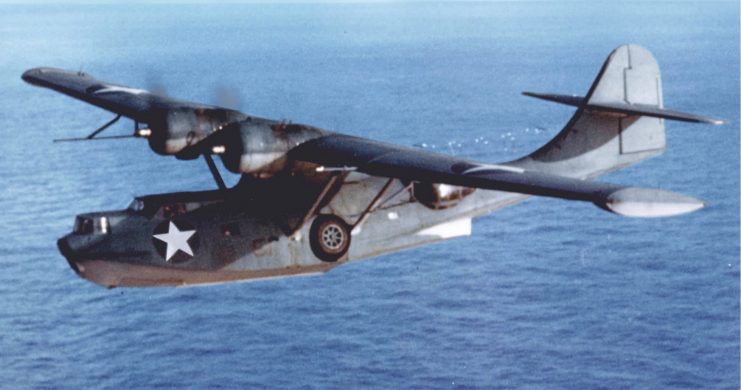PBY Catalina: Most of the important relics and artifacts from World War II have long since been refurbished, restored and placed in history museums to teach us about the realities and horrors of that conflict.
Some small items may still hang at the back of veterans’ closets, or in trunks stored in basements across Europe and the U.K., but the big ticket items have long since taken their place on shelves and behind glass in museums like the Holocaust Museum in Washington, D.C.
Occasionally, however, an item that was “hiding in plain sight” is discovered, and how it wasn’t found sooner is the first question that springs to mind.
Like a plane, for instance. How is it possible to overlook a plane laying at the bottom of Erne Lough in Ireland?
Easily, it seems, if the PBY Catalina recently discovered there is any indication of the way things can be overlooked even when they’re resting in one’s backyard, so to speak. The Catalina plane played a pivotal role in the war by giving cover to Allied convoys in the Atlantic.

The seaplanes were known as “flying boats,” historians say, and this one was deployed from a Royal Air Force (RAF) base nearby, at Castle Archdale, in County Fermanagh.
The plane was first discovered last year, when a survey was being conducted of the lough. The team, the Lough Erne Survey Team of the Charts Special Interest Group (CSIG) told officials about their discovery, and what they believed they’d found.
Soon a sonar survey was underway to confirm their suspicions, and sure enough, their theory was proven correct. The plane was resting 148 feet (45 meters) below the surface.
The sonar survey was conducted by staff from Stormont’s Department of Agriculture, Environment, and Rural Affairs (DAERA), and led by marine archaeologist Rory McNeary. When McNeary spoke of the project to Ireland’s BBC, he was quick to credit the CSIG men for their curiosity, which directly led to the discovery of a crucial piece of World War II aviation history.
McNeary told the BBC, “Had the site not been reported, a unique underwater heritage asset would have been overlooked. Studying the seaplane will be of immense interest to professional and amateur historians alike.”
Fortunately, the moment the plane’s identity as a WW2 wreck was verified, the site instantly received a designation of protection, meaning that it is illegal for anyone to approach the PBY or remove something from it without the express permission of authorities.
The Protection of Military Remains Act, passed in 1986, ensures that it is an offence for anyone to alter the plane in any way. In other words, divers in search of wartime memorabilia are banned from even approaching the site, just to explore it.
McNeary stressed to the BBC that it isn’t just the plane’s equipment that must not be disturbed; there may be bodies in it or nearby, too.
How or why the plane crashed into the sea isn’t really important now, but what matters is that at least one person was in it – the pilot – and perhaps more.
He may very well still be in there, or at least his remains, and it’s against the law to interfere with them in any way.
“Given that, there is still the possibility of human remains,” McNeary cautioned the public during his interview with the BBC, “and unexploded ordnance being found at the site, we would ask all people to fully recognize its protected status.”
The government is keen to ensure that the plane, and perhaps the man at its helm, is treated with the respect any military crash site deserves.
Another Story From Us: WW2 Bomb Suddenly Explodes in German Field Leaving Giant Crater
This is not the first time a decades-old plane has turned up unexpectedly in the U.K., or even the second. In 2017, a ground survey revealed an RAF Spitfire, a plane that had been used in the Battle of Britain was buried in a field in County Monaghan.
That story’s ending was a happier one: the pilot had bailed out before the crash, and survived.
